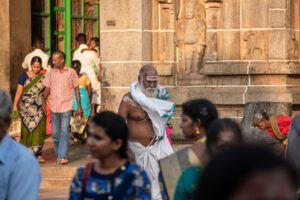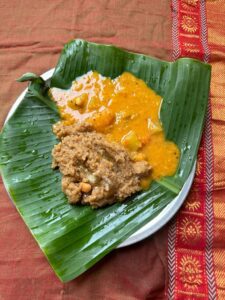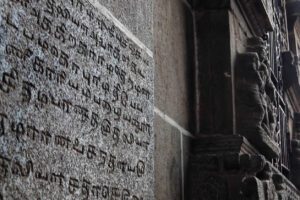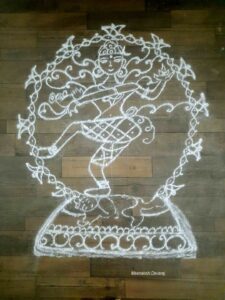Celebrated for over 1,000 years, Thiruvathirai is a grand celebration featuring cultural performances, resonating hymns, and the preparation of exquisite dishes like Thiruvathirai Kali and Ezhu Kari Kootu.

Chidambaram is one of the five sabhas (courts) of Nataraja, where Thiruvathirai is celebrated with much pomp. (iStock)
Devotees throng the streets of Chidambaram, eager to catch a glimpse of the grand celebration at the Thillai Natarajar Temple. The air is filled with the sweet fragrance of kali, a jaggery-based preparation, and the enticing aroma of the spice mix in a 7-vegetable kootu. Mallakambh and Silambam artistes gracefully perform their art forms, dedicating their skills to the deity – Shiva, while resonating hymns and chants of Thiruvempavai echo within the temple complex and through adjacent lanes.
For Paranjothi, a 55-year-old, the Thiruvathirai or the Arudra Darisanam, a Hindu festival, conjures vibrant imagery during the Tamil month of Margazhi.
This year, Margazhi Thiruvathirai falls on 27 December, 2023. The festival holds great importance as it showcases and celebrates the cosmic dance of Lord Shiva.
“I used to live near the temple in Chidambaram. My friends and I, after a visit to the banks of the Vellar River, would return in time to watch the temple get decked during the festival. We would always find a spot near one of the lanes, and the beautiful image of the north gopuram is etched in my mind,” recalls Paranjothi, an engineer who has now moved to a more commercial part of Chidambaram.
“Chidambaram, being one of the five sabhas (courts) of Nataraja, celebrates Thiruvathirai with much pomp. Lord Nataraja here is adorned with 30-odd varieties of sacred liquids, symbolising a special abhishekam,” he adds.

Chidambaram, Tamil Nadu. (iStock)
This year, the Margazhi Thiruvathirai witnesses lakhs of devotees in Chidambaram, eager to soak in the special fanfare.
“It is believed that by witnessing the cosmic dance during Arudra, one can attain spiritual benefits,” shares 80-year-old Visalaktchi, who has travelled from Chennai to witness the festival for the 30th time in Chidambaram.
Cultural performances play a significant role during this time.
Ellaalan, a Silambam asan from Chidambaram, explains the uniqueness of this period.
“If Madurai is famously called ‘Thiruvizha Nagaram,’ the next in line is Chidambaram. Here, three things are special – The Arudhra Dharisanam which happens twice a year – once during the Tamil month of Aavani and then during Margazhi, then the Pongal festival. During these festivals, we showcase Marabu Kalaigal (Traditional forms), like Silambam, Mallakambh, Parai, and so on,” he shares.
On 26 December, Ellaalan and his team performed Silambam and Mallakambh outside the Nataraja Temple to a huge crowd.
“One can find Tamils from across the world here during the festival. People like coming back to their roots during this time. Since the festival is also celebrated by Sri Lankan Tamils, one can find those from the Sri Lankan Tamil diaspora as well,” he shares.
In the culinary realm, two special dishes take centre stage on the day of Thiruvathirai. Shanthi Ramachandran, a retired banker-turned-home chef, shares, “We celebrate Thiruvadirai at home by making Thiruvathirai Kali and Thaalagam, also known as Ezhu Kari Kootu, offering them as neivedhyam (offering) to Lord Shiva after chanting his name during a small pujai (ritual).”
The Ezhu Kari Kootu, meaning seven-vegetable curry, is made using tubers of choice such as brinjal, broad beans, pumpkin, ash gourd, sweet potato, etc. To accompany it, there is Kali, a sweet offering made by coarsely grinding rice and moong dal and simmering it with jaggery syrup.

Thiruvathirai Kali and Kootu. (Uma Raghuraman)
“Good-quality rice and moong dal are washed, dried, and roasted to a deep golden colour. They are then powdered to a moderately smooth consistency. The sweetest jaggery, preferably the round ball-shaped ones, works best. Coconut, cardamom, and a little ghee are added. In those days, cashews were not included, becoming an ingredient only later,” elaborates Shanthi.
Food historian and food raconteur Rakesh Raghunathan, explains the prominence of Kali in the festival, attributing it to a legend involving a devote Shaivaite named Chendhanar from the village in Chidambaram.
A devotee of Shiva, Chendhanar found himself in a momentous encounter when the lord himself graced his doorstep. However, in a time of humble means, all Chendhanar could offer was something made from leftover rice and jaggery syrup – the now ubiquitous Thiruvathirai Kali.
Legend has it that on the following day, as the sanctum opened, people discovered the remnants of the Kali. “This fortuitous event coincided with Thiruvadhurai day, eventually establishing the tradition of preparing Kali on this auspicious occasion,” he shares.
“If you look at the Ezhu Kari Kootu, it consists of fresh and seasonal produce that people typically buy during Pongal. It includes various country vegetables such as different gourds, pumpkins, cluster beans, and broad beans. When rice is given, rice grits are produced, and Thiruvadhira Kali is made with broken rice. Back in the day, there might have been rice grits left towards the end of the harvest season. So, just before the new batch of rice comes in with the harvest, people would have prepared dishes like Kali,” he observes.
Hymns and literature too play a crucial role in the Thiruvathirai festival, celebrated for more than 1,000 years.
The festival finds mentions in the 7th-century poet-saint Thirugnana Sambandhar’s Tevaram, describing how it was celebrated in present-day Mylapore.
“Thiruvempavai, a hymn about Lord Shiva, is chanted during this festival. People who know and have learned Tevaram and Thiruvasakam recite the relevant poetry, either at the temple or at home,” notes Shanthi.

The festival finds mentions in the 7th-century poet-saint Thirugnana Sambandhar’s Tevaram, describing how it was celebrated in present-day Mylapore. (Stock)
Meenakshi Devaraj, a heritage enthusiast and kolam expert throws light on the mention of the festival in various texts. “There are lines in Sangam literature that talk about Margazhi Thiruvadhurai. There are inscriptions from the 11th century, such as those in the temples of Thiruvottiyur, that mention the Margazhi Thiruvadhurai festival. The Paripadal, another poetic work belonging to the Sangam time, also speaks of the festival,” she explains.
However, Ellaalan raises a worrisome observation. Numerous inscriptions from temples, including those within Chidambaram, signifying the festival, are gradually fading away due to neglect. “They are being painted over without regard for their historical significance, and it’s disheartening to witness,” he expresses with regret.

Nataraja kolam for Thiruvathirai by Meenakshi. (Supplied)
Rituals vary in different places. For instance, on the Kongu side, the celebration includes a Mangalya Nombu. “The day before Arudhra, they celebrate Margazhi Nombu for the well-being of the husband and family. The rituals and kolam differ from other regions. In the Kongu belt. The kolams incorporate Ashtamangalyam items, or Mangala porutkal (auspicious items) such as flowers, mirrors, lamps and so on,” shares Meenakshi. “This year, for the festival, I have crafted a Nataraja kolam!” she adds.
Shanthi highlights a unique tradition in her household. After the pooja for the deity, a manjal charadu (sacred yellow thread) is placed alongside other pooja items. Later, this thread is tied on the wrist or neck of all the women at home. “This is a very distinctive cultural practice in my family,” she says.
Despite variations in regional customs and evolving practices, the celebration of Thiruvathirai, deeply rooted in Saivism, has withstood the test of time. While adapting to different cultural nuances, it has retained its essence.
For locals in Chidambaram, such as Paranjothi and Ellaalan, the continued celebration of Thiruvathirai highlights its unremitting importance.
“I’m heading to Kerala for a Silambam workshop, but I made sure to participate in the Thillais performance before heading there. There’s no way I’ll miss these celebrations here!” Ellaalan signs off.

May 17, 2024

May 17, 2024

May 16, 2024

May 12, 2024

May 12, 2024

May 01, 2024